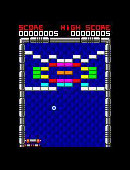
Contrary to popular belief, Pong wasn't the first real video game. That honour arguably goes to Spacewar! and its creators Steve Russell and friends at the Massachusetts Institute of Technology. Rarely imitated directly, Spacewar! is a top-down shooter in which you can spin your ship 360 degrees on a single plane and fire missiles at a human-controlled opponent. It's hardly like Pong.
So what could be the reason for the common misattribution? In 1972, Pong was certainly amongst the very first games to appear in an arcade cabinet, and later on a home console, but Spacewar! clone Computer Space nevertheless beat it to the arcades by a year.
In truth, history wants Pong to be the first, because it epitomises casual gaming. It may not have been the first game to appear on the scene, but it was the first to enlist a global audience. While Spacewar! has few clones, Pong has a million, and Arkanoid – the descendant here on trial today – is the best of them.
Inevitably, as the garden of technology has burgeoned in the sunlight of time, Arkanoid's presence has dwindled. For over a decade, it has been appearing intermittently as freeware in the gaming undergrowth. However, it shows no sign of dying. Some iPod Minis, for instance, come with a crude version of it pre-installed.
The goal of Arkanoid it to destroy a formation of rectangular blocks by bouncing a ball towards them. If you destroy all of the blocks, you win; if you fail to deflect the ball with your paddle – called the Vaus – and it falls out of the screen, you lose a life.
Some of the blocks contain power-ups that variously increase the number of balls in the field of play, expand or magnetise the Vaus, cast a forcefield across the bottom of the screen, fire a laser, and end the level prematurely.
Although the Vaus is visibly flat, its effect on the ball is that of a dome. If the ball drops straight onto the middle, it bounces straight back up. If it drops onto the edge, it bounces out towards the edge of the screen. Once sufficiently skilled, you can use the full range of the Vaus' domed surface to deflect the ball wherever you want.
The bricks at which you're aiming, meanwhile, are arranged so as to feature nooks, clefts and channels, and a major joy of Arkanoid is threading the ball into one of these and watching it crash from brick to brick like a bull in a china shop.
Being a retro title, Arkanoid doesn't have much to do to fulfil its technical brief. The graphics are entirely faithful to the coin-op original, and while the music and sound effects are sporadic, they succeed in evoking the mood of a 1980s arcade.
Since that majestic program first appeared, however, home conversions have struggled desperately with one important aspect of its gameplay, and the mobile doesn't fare any better. To properly play Arkanoid, you need analogue controls. While most home versions have got by with the abrupt, jerking bluntness of digital input, only the refined subtlety of analogue enables the player to enjoy the game at its best.
It may sound like a pedantic criticism, but it mattered so much to Nintendo that it saw fit to produce a specially made Vaus Controller to package with the game, while on home computers Arkanoid and its clones have usually made use of the mouse rather than the more obvious left and right cursor keys. Without such means to fall back on, the mobile version is confined to the lesser method.
So this Arkanoid isn't perfect, and nor is it innovative or particularly exciting. Nevertheless, while most retro titles have to settle for having been great in their context, nostalgic, historically interesting, and not much fun, Arkanoid's appeal as a game hasn't faded significantly in the 20 years since it arrived.
Arkanoid

